This is our step-by-step guide on how to dehydrate onions. Dehydrating onions is real easy to do. Almost every recipe we have uses onions in one way or another. So it just makes good sense to dehydrate what you use day-to-day and have it on hand when it’s needed.
In other words, dehydrate and store the foods you would normally eat every day.
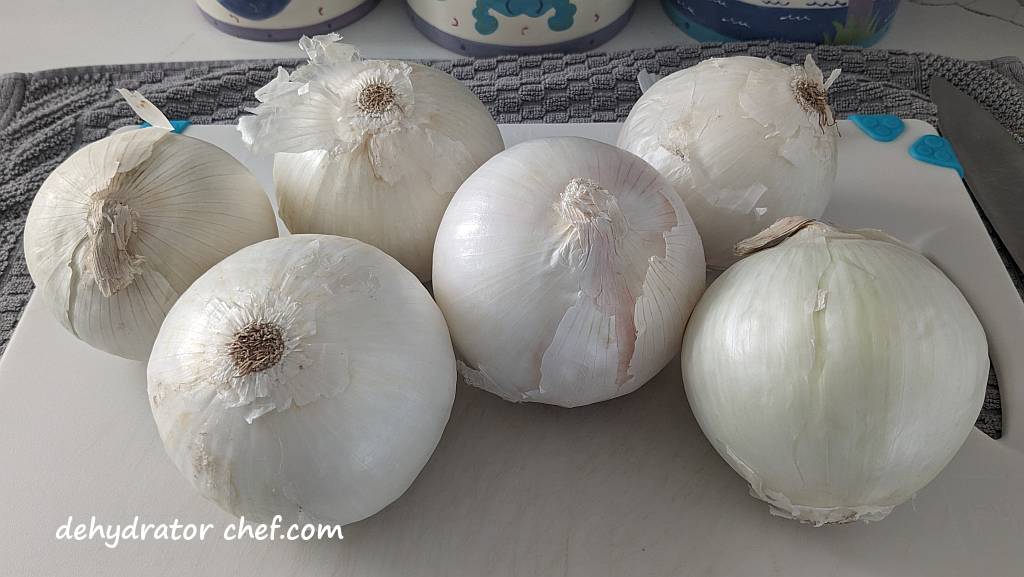
White, yellow, red, or sweet onions are all easy to dehydrate in a food dehydrator and they rehydrate well. The taste of hydrated onions ranges from mild and sweet to sharp and spicy, depending on the variety and the season.
These flavorful dehydrated onions are an outdoor kitchen pantry staple that can easily be included in any recipe. Dehydrated onions will fully rehydrate in 10 to 15 minutes in either hot or cold water. They can also be used to augment your favorite store-bought freeze-dried food pouches.
We seem to go through a lot of dehydrated onions for both day-to-day cooking and testing out our camping recipes before we get out in the field. You’ll go through them much faster than you might think. So you should plan on making a big batch and see how it goes.
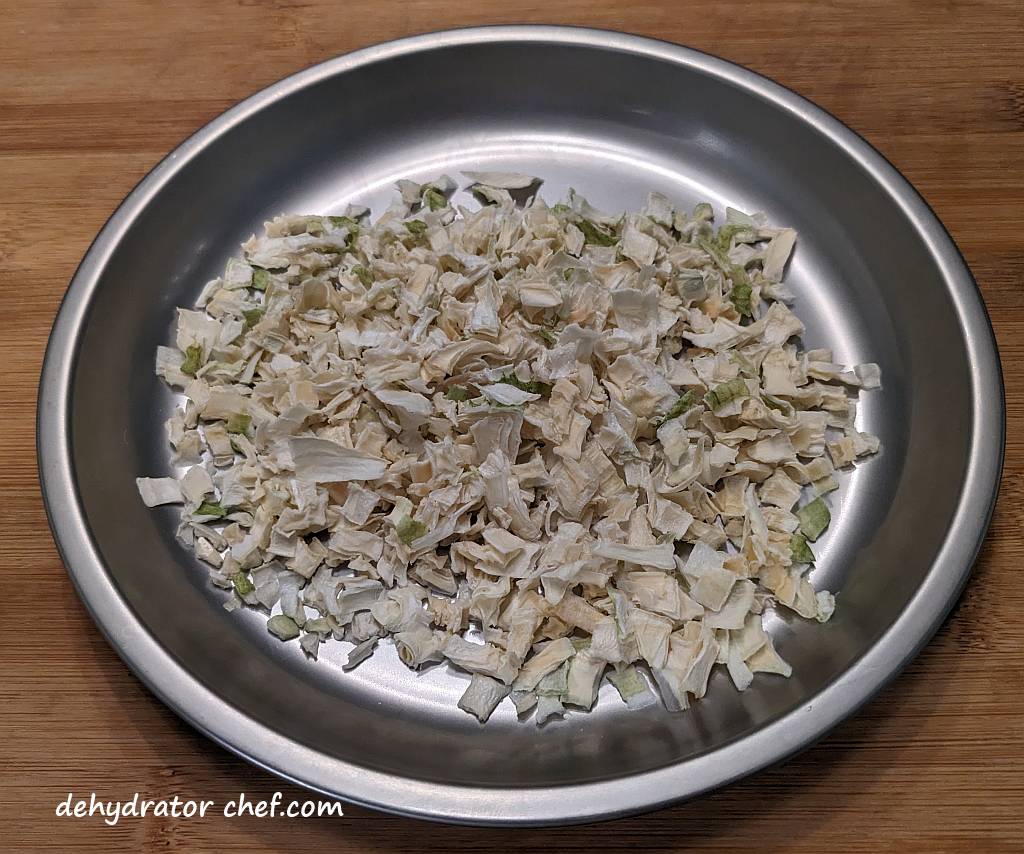
Onions may also have several health benefits, mostly due to their high levels of antioxidants and sulfur-containing compounds. Onions are a good source of vitamin C, folate, B6, and potassium. Most of us don’t get enough potassium. They are also a good source of prebiotic fiber, which feeds the beneficial bacteria in your gut.
Table of Contents
- How to Dehydrate Onions
- Supplies Needed to Dehydrate Onions
- Step 1. Process the Onions for Dehydration
- Step 2. Preparing the Dehydrator to Dehydrate Onions
- Step 3. Dehydrating the Onions
- Step 4. When are the Dehydrated Onions Done
- Step 5. Equalize and Conditioning Dehydrated Onions
- Step 6. Storing the Dehydrated Onions
- Hydration
- Weights, Measures, and Serving Sizes
- Dehydrated Onion Nutrition Information
- How to Use Dehydrated Onions in Camping Meals
How to Dehydrate Onions
It’s easy to dehydrate onions. The smell of drying onions is very strong and will make the entire house smell like … well smell like onions. So dehydration should be done outdoors or in a well-ventilated area.
All you need to dehydrate onions is a good quality food dehydrator. We use the Nesco food dehydrators., You can check out our food dehydrator guide and learn why we think Nesco offers the best bang for the buck.
Onions should be firm and free from blemishes or bruises. Local farmers’ markets are a good source for finding what is in season.
But don’t overlook less-than-perfect produce. Way too much gets thrown away because of a blemish or other minor imperfection that can easily be removed.
So, let’s get started dehydrating some onions.
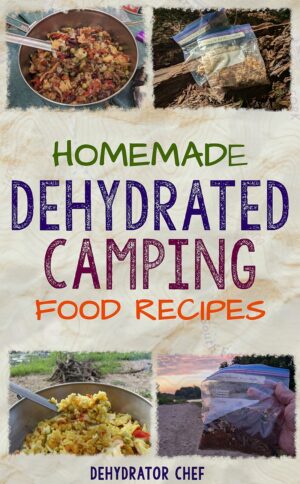 | Make Your Own Dehydrated Camping Meals Available only on Amazon.com Step-by-step instructions for 26 homemade trail meals, from hearty dinners to quick breakfasts. Includes exclusive recipes not published on the blog. Grab yourself a copy today. |
Supplies Needed to Dehydrate Onions
- Food dehydrator
- Removable fruit roll sheet inserts, one for each dehydrator tray
- Common kitchen tools, including cutting boards, cutting board scraper, chef’s knife, spatula, etc.
- Clear canning jars with tight-fitting lids
- Wide-mouth canning jar funnel
- Desiccant packets
Step 1. Process the Onions for Dehydration
Trim both the top and bottom of the onion. Next, peel off the outer layer. Save the scraps for homemade broth or your compost pile.
Next, cut the onion in half, from the top to bottom. Then slice each half into half-round sections, maybe 1/8 to 3/16 inches in width. Dice the half-round pieces into consistent and evenly sized onion pieces so they all dry at the same rate. My preference is to make them smaller for faster hydration.
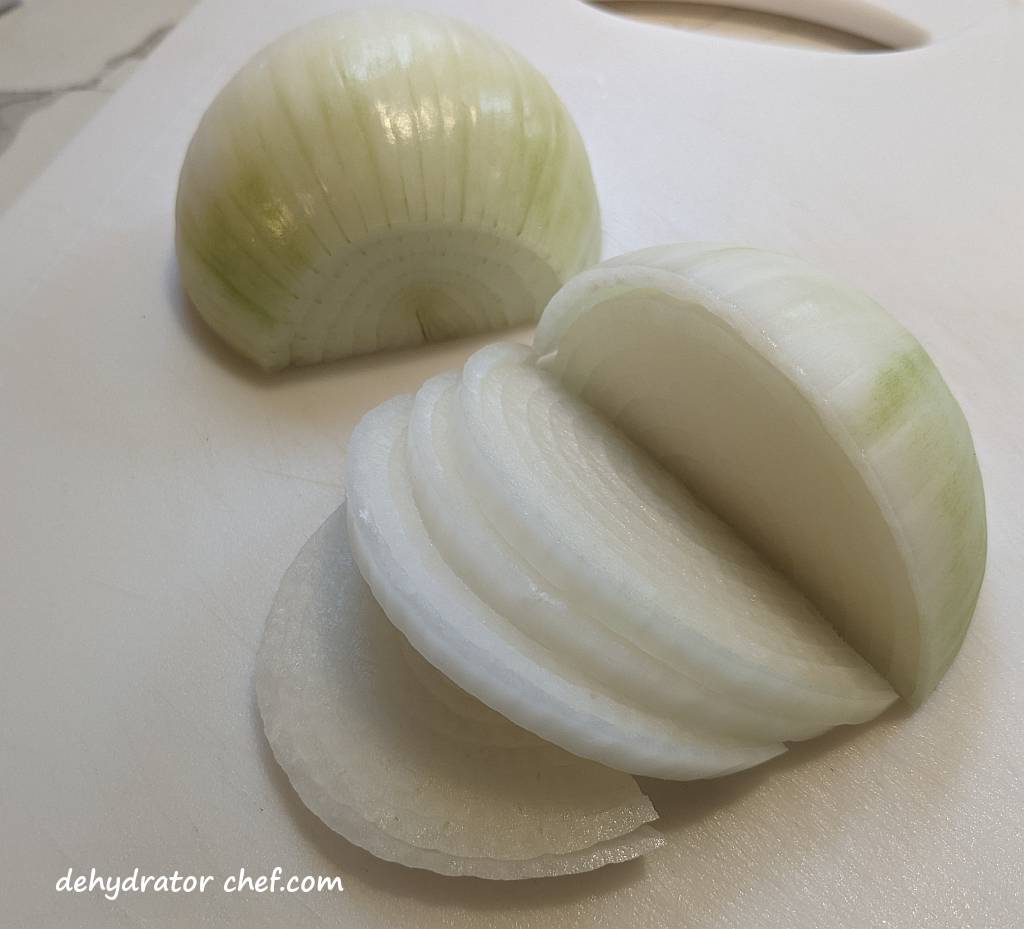
Taking the time now to process and optimize the onions for fast hydration makes for easier mealtime preparation.
Step 2. Preparing the Dehydrator to Dehydrate Onions
To dehydrate onions, we are using removable fruit roll sheet inserts on our Nesco FD-61 food dehydrator trays.
A cutting board scraper makes it much easier to transfer the processed onion pieces from the cutting board’s working surface to the dehydrator trays.
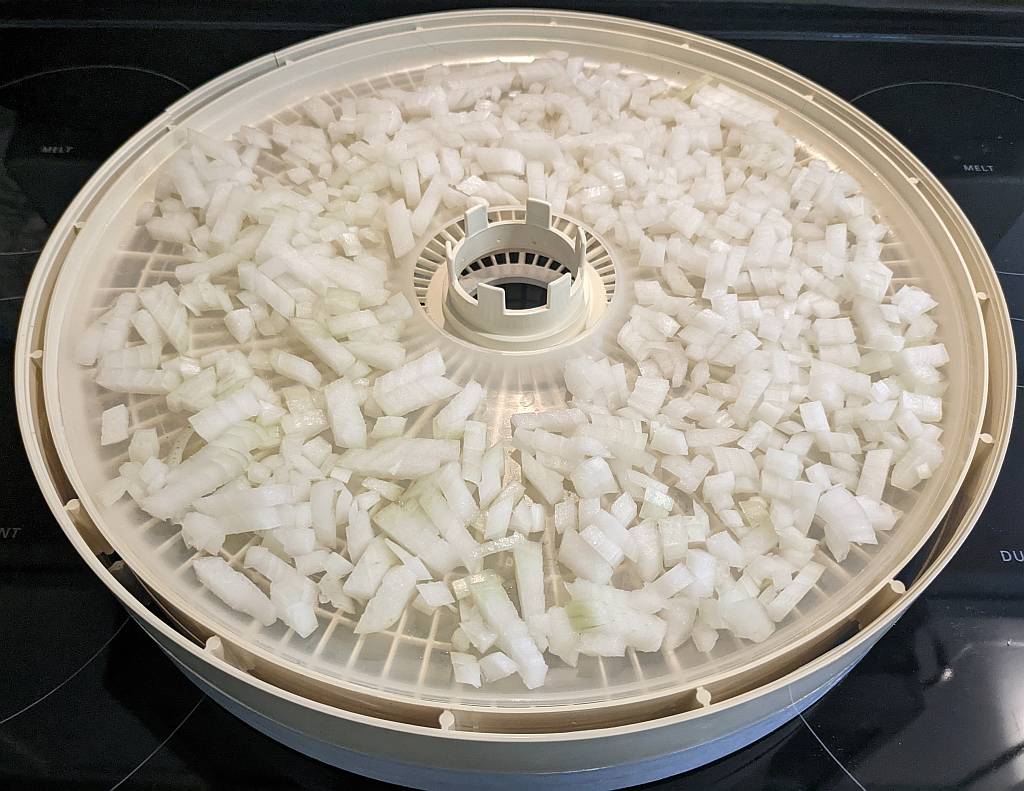
Evenly spread and layer the finely chopped onion on the fruit roll sheets, breaking apart any large clumps. If it’s too crowded, prepare another tray.
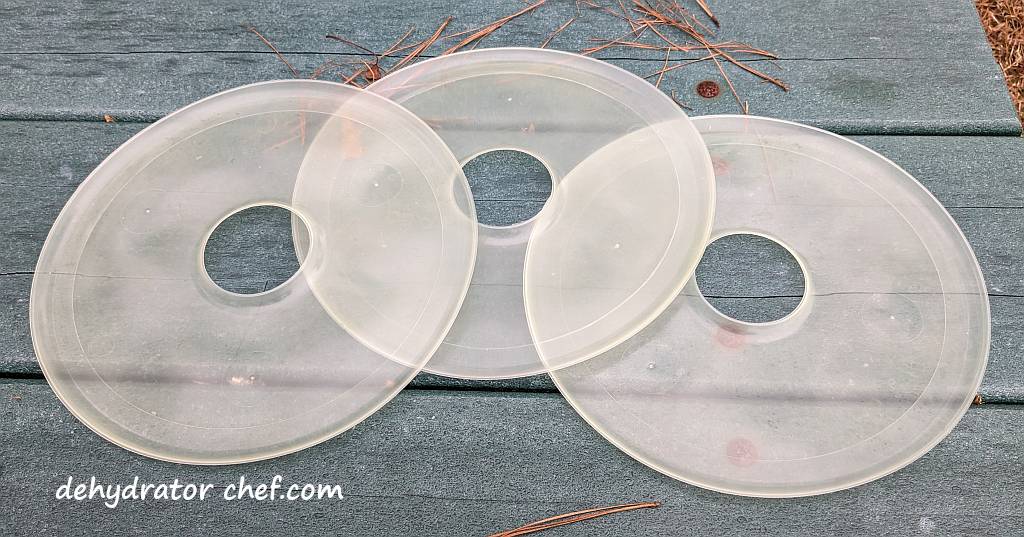
We will use these removable Nesco fruit roll sheet inserts on our food dehydrator for today’s project. They have over 3000 customer reviews with an average rating of 4.5 stars out of 5, which is evidence of a great product. Check out other Nesco food dehydrator products here.
The Nesco 13.5-inch round dehydrator tray has close to 119 square inches or .8 square feet of surface area for drying.
One large onion will easily fill up one of my Nesco FD-61 13.5-inch round dehydrator trays when using a fruit roll sheet insert.
Step 3. Dehydrating the Onions
Dehydrating onions produces a strong oniony smell, so open your windows or dehydrate in an outdoor or well-ventilated area.
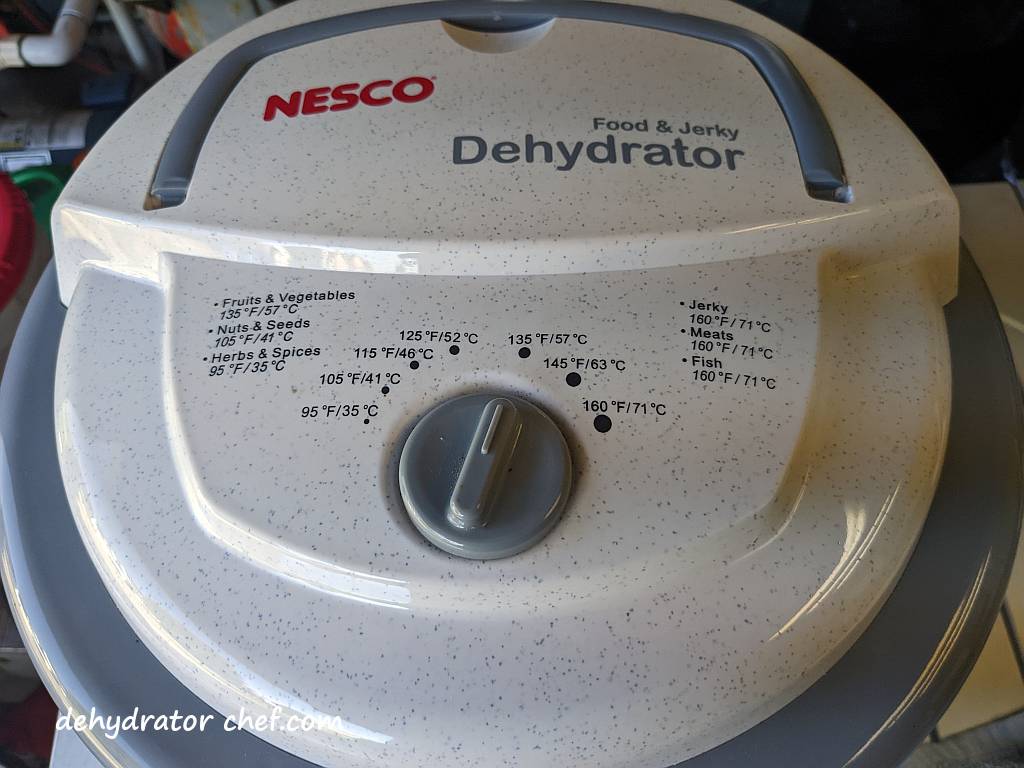
To speed up dehydration, set the drying temperature to 160 °F (71 °C) for 2 hours, then dial it back to 135 °F (57 °C) until dry, approximately 6 to 10 hours, depending upon the ambient temperature and humidity. Remember to use drying times as a guide.
Dehydrated onions may stick to the fruit roll sheets when they have finished drying. Using a spatula to move the drying onions around on the fruit roll sheets can help prevent some of the sticking.
Step 4. When are the Dehydrated Onions Done
Start checking for doneness in 6 hours. Onions take 6 to 10 hours to dehydrate at 135 °F (57 °C), depending on ambient temperature and humidity and your food dehydrator.
In reviewing the dehydrator logbook, dehydrating foods on hot, humid days may significantly extend the drying times. For example, one recent August, when the humidity routinely exceeded 90 percent and the National Weather Service issued many excessive heat warnings, a large batch of yellow onions we were drying took well over 24 hours to get sufficiently dehydrated. Over twice as long as expected.
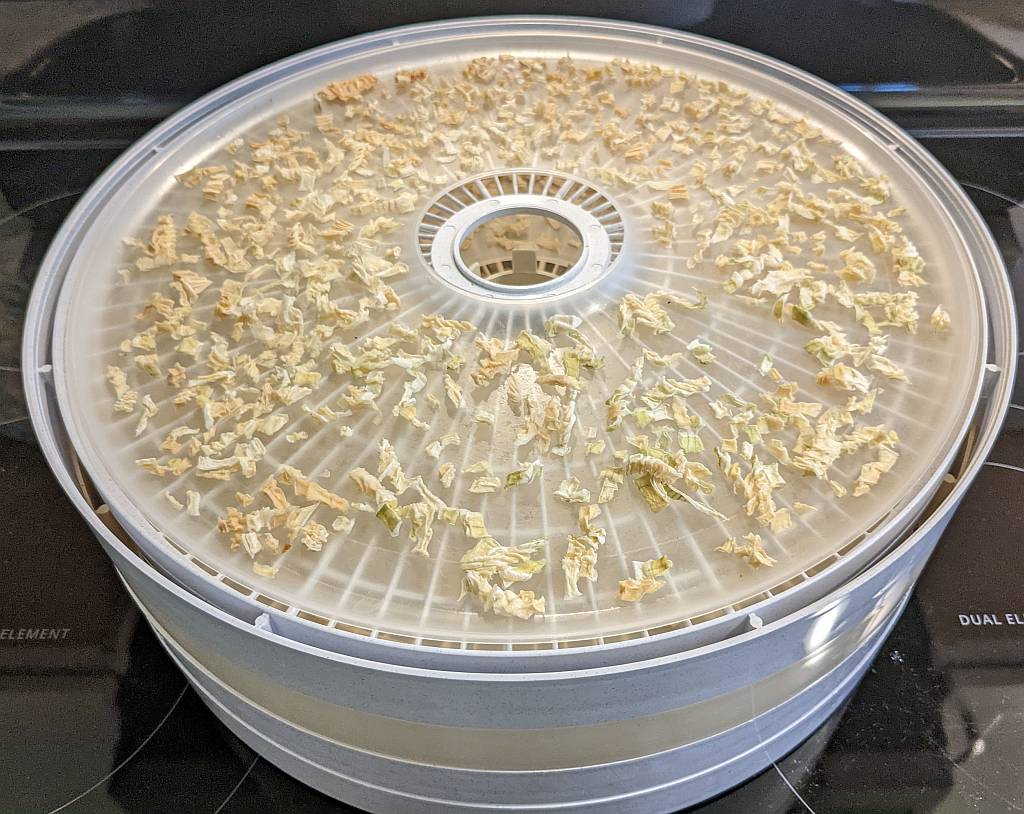
Drying times will vary depending on the dehydrator. Refer to your dehydrator owner’s manual for recommended temperatures and times for dehydrating specific foods.
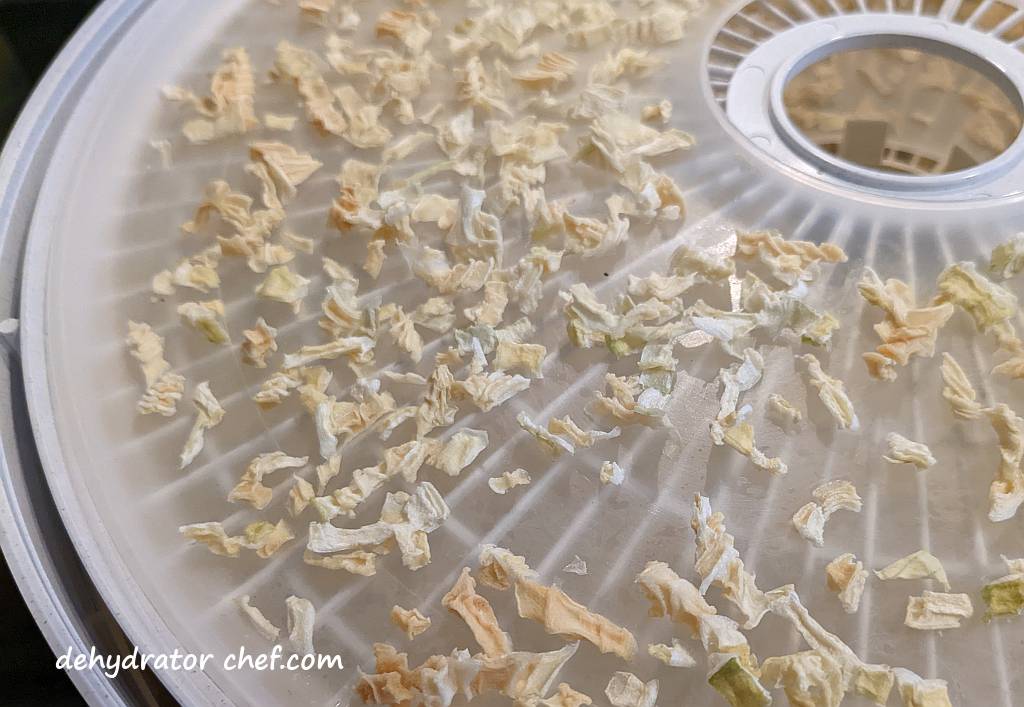
Warm dehydrating onions still in the food dehydrator will feel somewhat pliable and you may believe they need more drying time. Simply unplug the dehydrator, or just remove the tray and let it cool down. Then check again to be sure. They should be crisp or brittle when done.
Step 5. Equalize and Conditioning Dehydrated Onions
When the dehydrated onions are removed from the dehydrator, any remaining moisture may not be distributed equally among all the onion flakes because of their size, location, or position in the dehydrator. Equalizing and conditioning is a procedure used for freshly dehydrated foods that ensures any residual moisture remaining in any piece is spread or equalized among all the other pieces in the batch. Let the dehydrated onions equalize and condition in the storage container for 7 to 10 days.
We always recommend letting food items cool completely after they have finished dehydrating and before packing them into an airtight storage container with a tight-fitting lid for equalizing and conditioning. Warm food may cause sweating, which could provide enough moisture for mold to grow.
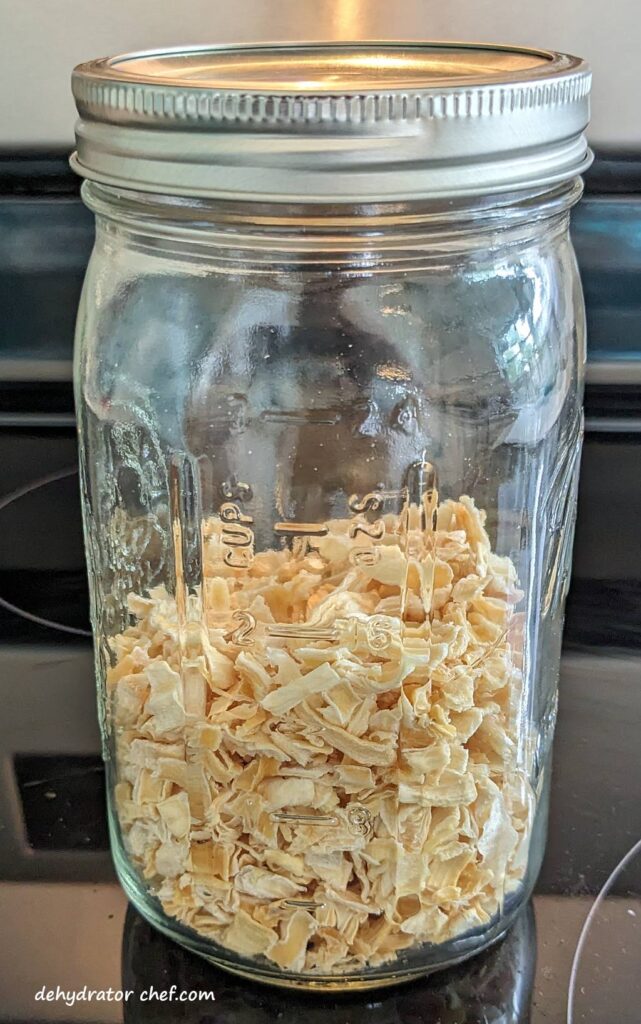
It does not take long for dehydrated food items to start hydrating from naturally occurring household humidity. Do not leave dehydrated food items exposed to the elements any longer than necessary because of the increased risk of mold growth.
After a short cooling period, pack the dehydrated onions into clean, dry, insect-proof containers with tight-fitting lids. We’ll use pint- and quart-size canning jars for this task.
A quality stainless steel or plastic canning jar funnel makes the messy job of getting dehydrated foods off the dehydrator tray removable inserts and into the canning jars an easy task. Take a minute or two and check them out here on Amazon.
Every day, check the jar for moisture. Roll the jar contents around and note any clumping or sticking. If seen, put the contents back on the dehydrator for several more hours. Since canning jars are clear, it’s easy to see what’s inside.
Step 6. Storing the Dehydrated Onions
Regardless of the type of storage container, it must be air-tight.
We use clear canning jars with a tight-fitting lid for this task. Since the canning jars are clear, it’s easy to see what’s inside.
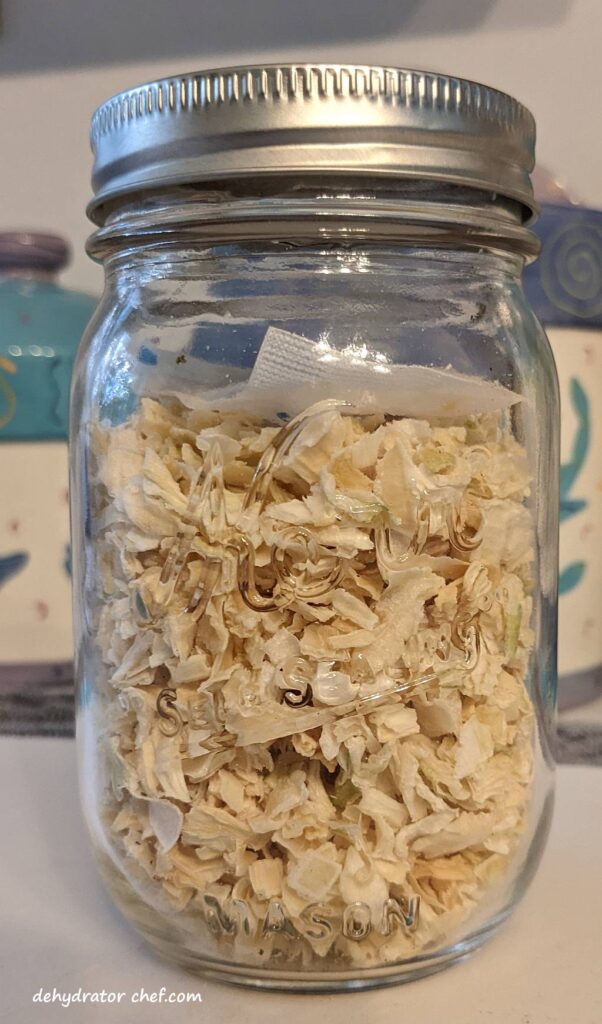
My preferred means of storing dehydrated onions are in clear canning jars with moisture-absorbing desiccant packets.
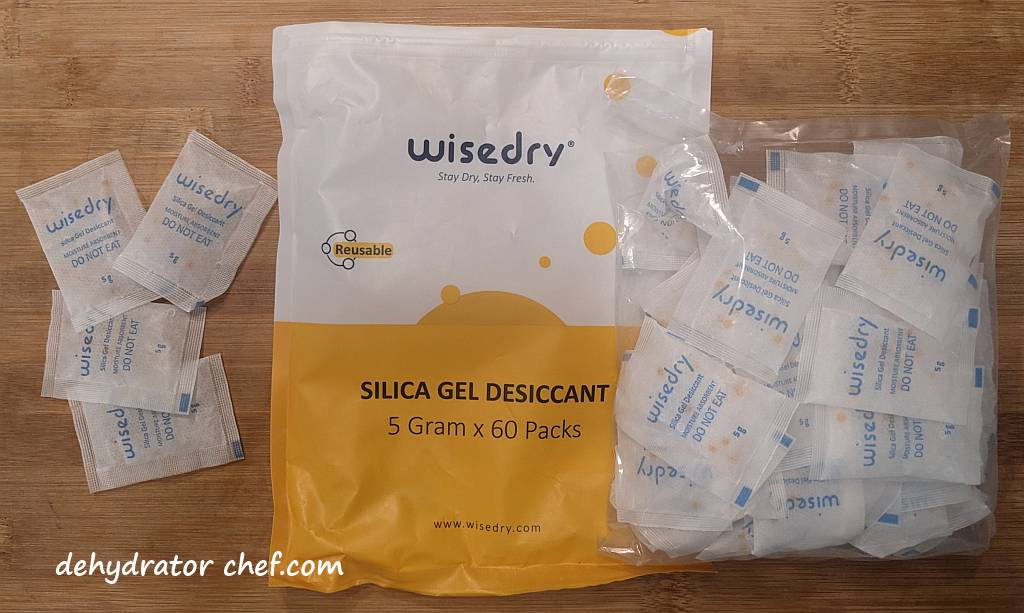
We use these inexpensive food-safe desiccant packets, which are available from Amazon. These 5-gram packets have over 5000 of mostly 4- and 5-star customer reviews, with an average of 4.7 stars out of 5. Our bag of 60 desiccant packets will last quite a while because they can be recharged and reused multiple times. Other food-safe sizes are available.
Do not leave your dehydrated food items exposed and unprotected any longer than necessary for the task at hand. It does not take long for dehydrated food items to naturally start hydrating from ambient household humidity. As such, this will increase the risk of mold growth.
Attach or include a short note describing the contents and the date the product was dehydrated. The note also informs us where to go in the dehydrator logbook to make another note.
Hydration
Hydrate onions using a 1-to-1 ratio of dehydrated onion to water.
We have used both cold water and hot water to hydrate. Plan on 10 to 15 minutes to fully hydrate.
If you’re supplementing a store-bought freeze-dried meal as we do, just add a tad bit more boiling water to the freeze-dried food pouch. Just use the same 1-to-1 ratio of dehydrated onions to water. Some freeze-dried meal instructions tend to overestimate the amount of water for hydration, so additional water may not be necessary.
Weights, Measures, and Serving Sizes
This information is summarized from the notes we keep in our logbook for most of our food dehydration efforts.
One jumbo white onion, weighing in at 0.94 pounds (429 grams), once trimmed and processed as described above, now weighed 0.83 pounds (377 grams). Once dried, the same jumbo white onion now weighed 1.3 ounces (37 grams).
A serving size of 1/2 cup raw onion will dehydrate to approximately 8 grams or about 2 tablespoons.
Dehydrated Onion Nutrition Information
Serving Size: 8 grams | Calories: 32kcal | Total Fat: 0g | Saturated Fat: 0g | Cholesterol: 0mg | Sodium: 3mg | Carbohydrate: 8g | Dietary Fiber: 1g | Sugar: 3g | Protein: 1g
How to Use Dehydrated Onions in Camping Meals
Okay, so you’ve got a jar of dehydrated onions sitting on the shelf in your pantry. Now what? Here are a few links to some practical, field-tested recipes that use dehydrated onions in our homemade camping meals.
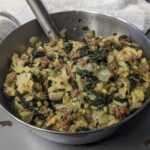


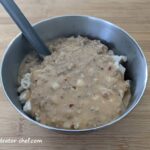
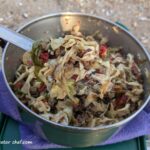
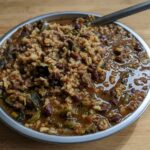
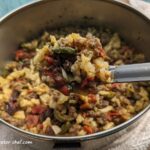
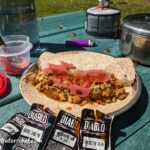

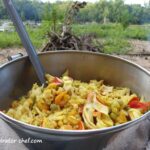

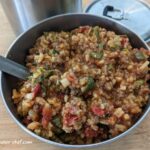

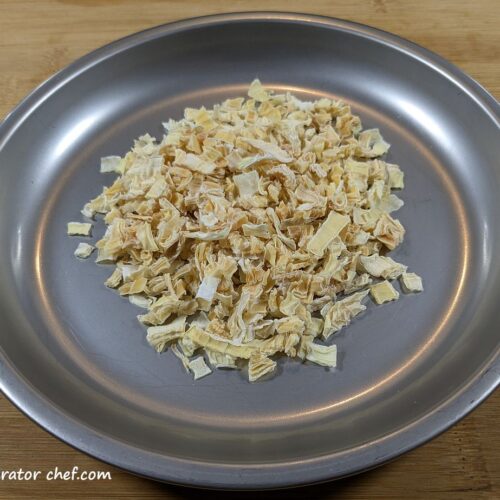
How to Dehydrate Onions
Equipment
- Removable fruit roll sheet insert (one for each dehydrator tray)
- Common kitchen tools (including cutting boards, chef's knife, etc.)
- Canning jars with tight-fitting lids
- Desiccant packets for moisture control (optional)
- Bench scraper (optional)
Ingredients
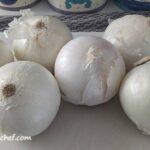 several large onions
several large onions
Instructions
Process the Onions
- Trim away the stem and root ends. Remove the outer layer and any harvest marks.several large onions
- Cut the onion in half, from top to bottom.
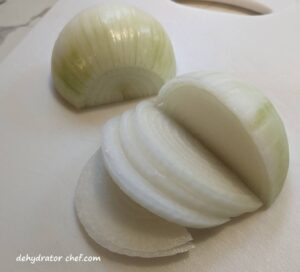
- Cut each onion half into half-round sections, approximately 1/8 to 3/16 inch (3 to 5mm) in width.
- Finely cut the half-rounds into strips or dice into approximately 1/8 to 3/16 inch (3 to 5mm) pieces.
Prepare the Dehydrator
- Spread and layer the finely diced onion evenly on the fruit roll sheets, breaking apart any large clumps. If it’s too crowded, prepare another tray.
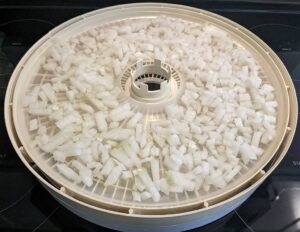
Dehydrate the Onions
- Set the dehydrator thermostat temperature to 135 °F (57 °C). Dry for 8 to 12 hours until done.
When is the Dehydrated Onions Done
- The onion flakes should be crisp and brittle when done.
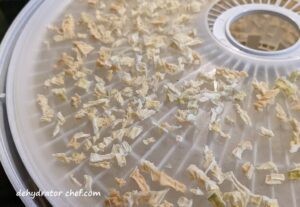
Equalizing and Conditioning the Dehydrated Onions
- After a short cooling period, loosely pack the dehydrated onions into a clean, dry canning jar with a tight-fitting lid, leaving some headspace.
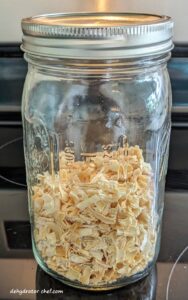
- Every day, for 7 to 10 days, check the jar for moisture. Roll the jar contents around and note any clumping or sticking. If seen, put the onions back on the dehydrator for several more hours.
- If you notice any mold at all, even the slightest bit, throw it all out.
Storing Dehydrated Onions
- Use appropriate-sized canning jars for storage. Depending on how well you dehydrate them and your pantry storage conditions, the dehydrated onions should keep for at least 12 months.
- An optional food-safe desiccant packet will aid with moisture control.
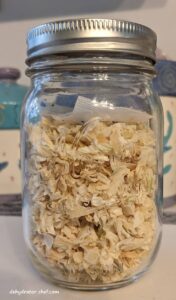
- Attach or include a label describing the jar contents and the date the product was dehydrated. The label identifies the canning jar contents, and the date helps with the rotation schedule. A first-in, first-out rotation helps us to use items that have been on the shelf the longest, so we're using the oldest food first.
Notes
Nutrition
Nutrition information is only an estimate and may differ depending on the ingredients you use.

3 replies on “How to Dehydrate Onions – Dehydrating Onions, A Step-by-Step Guide”
great info on how to dehydrate onions, thanx
you might call this the definitive guide to dehydrated onions
another great recipe